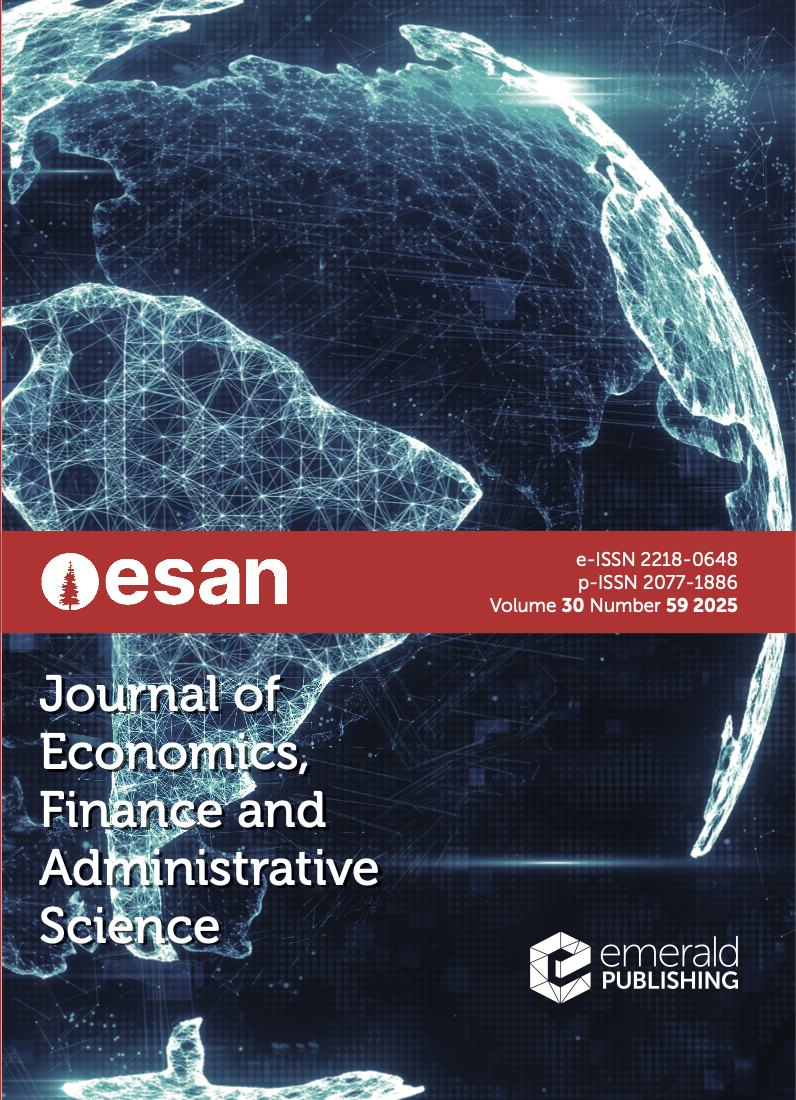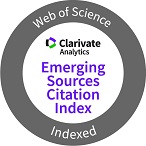Categorizing world regional art prices by artistic movement: an analysis of Latin American art
Keywords:
Hedonic pricing model, Latin American art, Style effects, Diversification, Art price indicesAbstract
PurposeThe literature on the potential benefits of art investing has yet to consider the effects of categorizing world regional art markets (e.g. Latin American art) by artistic styles or movements (e.g. Latin American surrealism, Latin American conceptual art, etc.). We propose that such categorization should be carried out and analyze the Latin American art market as an example.
Design/methodology/approachEleven artistic style price indices within the Latin American art market (30,288 artworks created by 293 artists and sold at auction between 1970 and 2014) are estimated using hedonic regressions: Abstract-geometric, abstract-informal, conceptual, costumbrismo, cubism, figurative, muralism, landscape, surrealism, nineteenth century and avant-garde. We find that several variables that rely on the corresponding Latin American art movement index have a significant relationship with painting prices.
FindingsThere is significant variation in the financial performance of the various price indices for Latin American art styles: the conceptual (10.33% annual real return), abstract geometric (1.97%), cubism (0.97%) and costumbrismo (0.91%) movements overperformed a market that exhibited an aggregate negative cumulated real return of 0.9% during the sample period. The average correlation between each of the styles was only 0.12. The estimated price index for paintings sold at Christie's and Sotheby's clearly outperformed the index estimated for the other auction houses, and we also found that paintings created by Latin American women artists yielded higher returns.
Practical implicationsOur results have practical applications for investors, collectors, auction houses and policymakers.
Originality/valueThis is the first paper to highlight the need to decompose art price indices by artistic movements at the regional level.
Downloads
References
Adams, R., Kräussl, R., Navone, M. and Verwijmeren, P. (2021), “Gendered prices”, Review of Financial Studies, Vol. 34 No. 8, pp. 3789-3839, doi: 10.1093/rfs/hhab046.
Angelini, F., Castellani, M. and Pattitoni, P. (2023), “You can't export that! Export ban for modern and contemporary Italian art”, European Journal of Law and Economics, Vol. 56 No. 3, pp. 533-557, doi: 10.1007/s10657-022-09759-0.
Arteaga, A. (2017), Exportar arte, una carrera de obstáculos, La Nación, Buenos Aires, Argentina, August 28th.
Barnitz, J. (2006), Twentieth-Century Art of Latin America, University of Texas Press, Austin.
Baumol, W.J. (1986), “Unnatural value: or art investment as floating crap game”, The American Economic Review, Vol. 76 No. 2, pp. 10-14.
Bocart, F., Gertsberg, M. and Pownall, R. (2022), “An empirical analysis of price differences for male and women artists in the global art market”, Journal of Cultural Economics, Vol. 46 No. 3, pp. 543-565, doi: 10.1007/s10824-020-09403-2.
Cameron, L., Goetzmann, W. and Nozari, M. (2019), “Art and gender: market bias or selection bias?”, Journal of Cultural Economics, Vol. 43 No. 2, pp. 279-307, doi: 10.1007/s10824-019-09339-2.
Campbell (2008), “Art as a financial investment”, Journal of Alternative Investments, Vol. 10 No. 4, pp. 64-81, doi: 10.3905/jai.2008.705533.
Campos, N. and Barbosa, R. (2009), “Paintings and numbers: an econometric investigation of sales rates, prices, and returns in Latin American art auctions”, Oxford Economic Papers, Vol. 61 No. 1, pp. 28-51, doi: 10.1093/oep/gpn020.
Candela, G. and Scorcu, A.E. (1997), “A price index for art market auctions”, Journal of Cultural Economics, Vol. 21 No. 3, pp. 175-196, doi: 10.1023/a:1007442014954.
Candela, G., Figini, P. and Scorcu, A.E. (2004), “Price indices for artists – a proposal”, Journal of Cultural Economics, Vol. 28 No. 4, pp. 285-302, doi: 10.1007/s10824-004-2529-x.
Castro, C. (2013), “Gabriel Pérez barreiro: ‘el Término Latinoamérica es una Abstracción que Sirve Para Simplificar y Eso es Algo que hay que Resistir’”, Artishock Revista de Arte Contemporáneo, February 4th.
Cinefra, J., Garay, U., Mibelli, C. and Pérez, E. (2019), “The determinants of art prices: an analysis of Joan Miró”, Academia. Revista Latinoamericana de Administración, Vol. 32 No. 3, pp. 373-391, doi: 10.1108/arla-06-2018-0121.
Contreras, V., Garay, U., Santos, M. and Betancourt, C. (2014), “Expropriation risk and housing prices: evidence from an emerging market”, Journal of Business Research, Vol. 67 No. 5, pp. 935-942, doi: 10.1016/j.jbusres.2013.07.013.
Coslor, E. and Spaenjers, C. (2016), “Organizational and epistemic change: the growth of the art investment field”, Accounting, Organizations and Society, Vol. 55, pp. 48-62, doi: 10.1016/j.aos.2016.09.003.
Cote, C. (2021), How to Diversify Your Portfolio with Alternative Investments, Harvard Business School Publishing, available at: https://online.hbs.edu/blog/post/how-to-diversify-your-portfolio
De Ridder, A., Eriksen, S. and Scholtens, B. (2024), “The art of valuation: using visual analysis to price classical paintings by Swedish Masters”, PLoS One, Vol. 19 No. 1, e0296906, doi: 10.1371/journal.pone.0296906.
Edwards, S. (2004), “The economics of Latin American art: creativity patterns and rates of return”, NBER Working Paper No. 10302, February.
Etro, F. and Stepanova, E. (2019), “On the efficiency of art markets. Evidence on return rates from old master paintings to contemporary art”, Working Papers – Economics, Universita' degli Studi di Firenze, Dipartimento di Scienze per l'Economia e l'Impresa.
Frost Art Museum and The Patricia & Phillip Frost Art Museum (2010), Embracing Modernity: Venezuelan Geometric Abstraction, Vol. 45, Frost Art Museum Catalogs.
Galenson, D.W. (2000), “The careers of modern artists”, Journal of Cultural Economics, Vol. 24 No. 2, pp. 87-112, doi: 10.1023/a:1007590329233.
Galenson, D.W. and Weinberg, B.A. (2000), “Age and quality of work: the case of modern American painters”, Journal of Political Economy, Vol. 108 No. 4, pp. 761-777, doi: 10.1086/316099.
Galenson, D.W. and Weinberg, B.A. (2001), “Creating modern art: the changing careers of painters in France from impressionism to cubism”, The American Economic Review, Vol. 91 No. 4, pp. 1063-1071, doi: 10.1257/aer.91.4.1063.
Galería de Arte Nacional (2005), Diccionario biográfico de las artes visuales en Venezuela, Galería de Arte Nacional, Fundación Cisneros, Caracas, Venezuela.
Garay, U. (2005), “Los mercados de capitales con aplicaciones al mercado venezolano”, Nota de Estudio, No. 11, p. 16.
Garay, U. (2018), “The Latin American art market: literature and perspectives”, Academia. Revista Latinoamericana de Administración, Vol. 31 No. 1, pp. 239-276, doi: 10.1108/arla-04-2017-0117.
Garay, U. (2021), “Determinants of art prices and performance by movements: long-run evidence from an emerging market”, Journal of Business Research, Vol. 127, pp. 413-426, doi: 10.1016/j.jbusres.2019.03.057.
Garay, U., Vielma, G. and Villalobos, E. (2017), “Art as an alternative investment: the case of Argentina”, Academia. Revista Latinoamericana de Administración, Vol. 30 No. 3, pp. 362-382, doi: 10.1108/arla-08-2016-0226.
Garay, U., Pérez, E., Casanova, J. and Kratohvil, M. (2022a), “Color intensity, luminosity, contrast and art prices: the case of Jean-Michel Basquiat”, Academia. Revista Latinoamericana de Administración, Vol. 35 No. 3, pp. 303-328, doi: 10.1108/arla-05-2021-0110.
Garay, U., Pérez, E. and Pulga, F. (2022b), “Color intensity variations and art prices: an examination of Latin American art”, Journal of Business Research, Vol. 147, pp. 158-176, doi: 10.1016/j.jbusres.2022.03.010.
Garay, U., Ríos, M., Sorensen, A. and Ter Horst, E. (2024), Do the Different Expressions of an Artist Offer the Same Financial Performance over Time? the Case of Fernando Botero, Academia Revista Latinoamericana de Administración, (forthcoming).
Ginsburgh, V. and Jeanfils, P. (1995), “Long-term comovements in international markets for paintings”, European Economic Review, Vol. 39 No. 3-4, pp. 538-548, doi: 10.1016/0014-2921(94)00060-d.
Goetzmann, W. (1993), “Accounting for taste: art and the financial markets over three centuries”, The American Economic Review, Vol. 83 No. 5, pp. 1370-1376.
Goetzmann, W. (1996), “How costly is the fall from fashion? Survivorship bias in the painting market”, in Victor, A.G. and Pierre-Michel, M. (Eds), Economics of the Arts – Selected Essays, Elsevier, Amsterdam.
Goetzmann, W., Renneboog, L. and Spaenjers, C. (2011), “Art and money”, The American Economic Review, Vol. 101 No. 3, pp. 222-226, doi: 10.1257/aer.101.3.222.
Goodwin, J. (2008), The International Art Markets: the Essential Guide for Collectors and Investors, Kogan Page, London.
Gurjar, S. and Ananthakumar, U. (2023), “The economics of art: price determinants and returns on investment in Indian paintings”, International Journal of Social Economics, Vol. 50 No. 6, pp. 839-859, doi: 10.1108/ijse-06-2022-0419.
Higgs, H. and Worthington, A. (2005), “Financial returns and price determinants in the Australian art market, 1973–2003”, The Economic Record, The Economic Society of Australia, Vol. 81 No. 253, pp. 113-123, doi: 10.1111/j.1475-4932.2005.00237.x.
Hodgson, D.J. (2022), “Artistic movement membership and the career profiles of Canadian painters”, Poetics, Vol. 90, 101595, doi: 10.1016/j.poetic.2021.101595.
Hodgson, D.J. and Hellmanzik, C. (2019), “Relationships between artistic movements and careers of modern artists: evidence from hedonic regressions with auction data”, Journal of Cultural Economics, Vol. 43 No. 2, pp. 309-337, doi: 10.1007/s10824-019-09343-6.
Korteweg, A., Kräussl, R. and Verwijmeren, P. (2016), “Does it pay to invest in art? A selection‐corrected returns perspective”, Review of Financial Studies, Vol. 29 No. 4, pp. 1007-1038, doi: 10.1093/rfs/hhv062.
Kraeussl, R. and Logher, R. (2010), “Emerging art markets”, Emerging Markets Review, Vol. 11 No. 4, pp. 301-318, doi: 10.1016/j.ememar.2010.07.002.
Kräussl, R., Lehnert, T. and Martelin, N. (2016), “Is there a bubble in the art market?”, Journal of Empirical Finance, Vol. 35, pp. 99-109, doi: 10.1016/j.jempfin.2015.10.010.
LeBlanc, A. and Sheppard, S. (2021), “Women artists”, Department of Economics Working Papers, Williams College, No 2021-09.
Li, Y., Ma, M. and Renneboog, L. (2022), “Pricing art and the art of pricing: on returns and risk in art auction markets”, European Financial Management, Vol. 28 No. 5, pp. 1139-1198, doi: 10.1111/eufm.12348.
Martin, M. (1999), “The Latin American market comes of age, some thoughts on the past twenty-one years”, in Theran, S. (Ed.), Leonard's Price Index of Latin American Art at Auction, Palgrave Macmillan, London, (1999).
McAndrew, C. (2023), The Survey of Global Collecting, Art Basel and UBS, p. 149.
McAndrew, C. (2024), The Art Market 2023, The Art Basel and UBS Global Art Market Report, p. 254.
Meleddu, M. and Pulina, M. (2024), “Assessing complementarity and substitution effects of cultural events in rural communities: insights from a Mediterranean island”, June, Journal of Cultural Economics, Vol. 48 No. 4, pp. 615-644, doi: 10.1007/s10824-024-09511-3.
Pesando, J.E. (1993), “Art as an investment: the modern market for prints”, The American Economic Review, Vol. 83 No. 5, pp. 1075-1089.
Pownall, R. and Graddy, K. (2016), “Pricing color intensity and lightness in contemporary art auctions”, Research in Economics, Vol. 70 No. 3, pp. 412-420, doi: 10.1016/j.rie.2016.06.007.
Radermecker, A.-S. and Alvarez de Toledo, F. (2022), “The history of art markets: methodological considerations from art history and cultural economics”, InternationalJournal of Digital Art History, Vol. 5.
Reitlingler’s, G. (1961), The Economics of Taste: the Rise and Fall of Picture Prices 1760-1960, Barrie and Rockliff, London.
Renneboog, L. and Spaenjers, C. (2012), “Buying beauty: on prices and returns in the art market”, Management Science, Vol. 59 No. 1, pp. 1-18, doi: 10.1287/mnsc.1120.1580.
Renneboog, L. and Spaenjers, C. (2014), “Investment returns and economic fundamentals in international art markets”, Discussion Paper 2014-018, Tilburg University, Center for Economic Research.
Rosen, S. (1974), “Hedonic prices and implicit markets: product differentiation in pure competition”, Journal of Political Economy, Vol. 82 No. 1, pp. 34-55, doi: 10.1086/260169.
Schulze, G. (1999), “International trade in art”, Journal of Cultural Economics, Vol. 23 Nos 1/2, pp. 109-136, doi: 10.1023/a:1007551515187.
Shi, Y., Xu, H., Wang, M. and Conroy, P. (2017), “Home bias in domestic art markets: evidence from China”, Economics Letters, Vol. 159, pp. 201-203, doi: 10.1016/j.econlet.2017.08.015.
Steiner, L., Frey, B. and Resch, M. (2013), “Home is where your art is: the home bias of art collectors”, ECON – Working Papers 135, Department of Economics – University of Zurich.
Stepanova, E. (2016), “The impact of color palettes on the prices of paintings”, available at: https://ssrn.com/abstract=2807443
Taylor, D. and Coleman, L. (2011), “Price determinants of aboriginal art, and its role as an alternative asset class”, Journal of Banking and Finance, Vol. 35 No. 6, pp. 1519-1529, doi: 10.1016/j.jbankfin.2010.10.027.
Theran, S. (1999), Leonard's Price Index of Latin American Art at Auction, Palgrave Macmillan, London.
Tian, Y., Lautz, S., Wallis, A.O.G. and Lambiotte, R. (2021), “Extracting complements and substitutes from sales data: a network perspective”, EPJ Data Science, Vol. 10, p. 45.
Traba, M. (1994), Arte de América Latina, 1900-1980, Banco Interamericano de Desarrollo, EEUU, Washington, DC.
Vosilov, R. (2015a), “Sculpture as an alternative investment: an analysis of price dynamics between sculpture and equity and bond markets”, Journal of Alternative Investments, Vol. 17 No. 4, pp. 21-45, doi: 10.3905/jai.2015.17.4.021.
Vosilov, R. (2015b), “Art auction prices: home bias, familiarity and patriotism”, available at: https://ssrn.com/abstract=2686527
Wang, F. (2023), “Do emerging art market segments have their own price dynamics? Evidence from the Chinese art market”, International Review of Economics and Finance, Vol. 84, pp. 318-331, doi: 10.1016/j.iref.2022.11.015.











